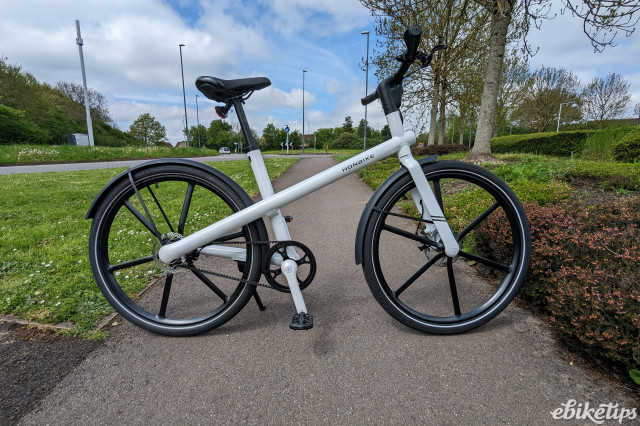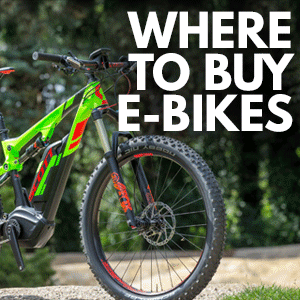Review: Tern HSD S8i

Overview
- Hugely practical
- One size really does fit all
- High spec
- Really deserves a better motor
- Hub can be reluctant to shift under load
- You can’t give a grown-up a lift
The Tern GSD remains my favourite everyday cargo bike, and the HSD doesn’t quite do enough to knock it off that particular perch. Really this is a different thing though: you shouldn’t think of it as a cargo bike so much as a super-versatile city bike. It’s compact, you can carry loads of stuff, and it folds down for storage. It’s a great addition to the range and for many people will be more attractive than the larger GSD, which has a load capacity that not everyone will need.
If you’ve seen Tern’s GSD and its Vektron folding e-bike then you’ll immediately see the family resemblance here. The low-step aluminium frame is heavily built. The long steerer has a folding mechanism and a quick release stem assembly, and the seatpost is a double quick release that can be dropped down right to the frame. The bike will accommodate pretty much anyone in the single size frame that Tern makes, and the geometry has been tweaked a bit so the cockpit is a bit longer for taller riders. I’m 1.89m tall, so a lot nearer the bike’s 1.95m upper limit than its 1.50m lower one; the bike felt perfectly natural and the position comfortable and commanding for town riding.
Unlike the GSD, the HSD’s rear rack isn’t an integral part of the frame. It still has an impressive load limit of 60kg, so that means that you won’t ever overload it with shopping, or a child in a child seat; Thule Yepp Maxi, Yepp Nexxt Maxi, and Bobike GO Maxi child seats work on the rack without any adapters. The padded Sidekick seat from the GSD will work on the rack too, and Tern says it’s developing a passenger kit with footpegs for older kids and smaller adults, but obviously the 60kg limit means you can’t give just anyone a lift. At least not under the terms of the warranty. Probably the rack would take a big bloke easily enough without any issues. We wouldn’t know, of course, because we haven’t tried or anything.
The ride: a good city companion
The HSD is solidly built, and to mitigate that Tern has worked with Suntour to develop a custom short-travel suspension fork for the 20” wheels. You can lock it out if you want to, but I didn’t ever bother, because it goes about its business in a pretty unobtrusive way. Suspension forks on e-bikes often suffer from flex fore and aft under braking, but because the small wheels mean short stanchions it’s not really an issue here. The bike is better for having the fork, which isn’t always the case. Because I’m running a lot of seatpost there’s a fair bit of flex mitigating the bumps at the rear too; if you’re a shorter rider you won’t benefit from that quite as much. There’s a bit of give in the Schwalbe Big Ben 55mm tyres, but they don’t do quite as much in terms of suspension as you might expect.
Overall though the bike is pretty comfortable to ride and easily adjustable for a wide range of riders. This is the kind of bike that you can buy, and everyone in the family can ride easily with minimal faffing. The seatposts have a scale on the rear too, so you can remember your settings for the next ride. It’s naturally a more upright position for smaller riders as there isn’t too much up/down adjustment available at the stem, but everyone that rode the HSD was happy enough with the position.
Luggage capacity: you’ll be surprised!
A big use case for a bike like this is just general city use: doing the weekly shop, moving stuff and kids about, being useful. Tern has developed the Cargo Hold 37 Panniers specifically for this bike, and they’re great. They fold flat against the bike when not in use, and they have a roll-top closure with a Fidlock clasp for keeping the rain off your stuff. If it’s not raining you can fold the roll top back inside the pannier and they just turn into big bucket bags you can chuck your weekly shop into; the fidlock strap can be used to stabilise them across the top. That design also means you can carry stuff that’s bigger than the pannier fairly easily.
The rack is long enough to carry some pretty sizeable loads on top of what the panniers can hold, and at the front there’s a universal mount that’ll take the small rack from the GSD (beer crate sized) or any number of bags via a Klickfix adaptor. You’re unlikely to run out of room for daily use, and bigger one-off trips are possible. There’s even a little zipped frame bag stuffed between the motor and the rear wheel that you can stick an extra lock in; the HSD comes with an Abus rear wheel lock (that uses the same key as the battery) but if you’re about in town you’ll want to lock it something solid. It’s not so bulky or heavy that it couldn’t be lifted into a waiting van.
Cargo bikes can be a pain to store, but that’s one of the HSD’s major selling points. The GSD is no longer than a standard city bike, and the HSD is smaller still; it’s only a bit bigger than a folding bike which is extraordinary given how much stuff it can cart about. I’ve already mentioned that the steerer and seatpost can be dropped to make it an even smaller package, and it has one last trick: the rear rack has feet on the back so you can stand it on its end. You only need a bit of real estate about a metre square to store it, which makes it an option even if you live somewhere that’s not spacious. Assuming there aren’t any stairs in the way: this is not a bike you’re going to want to haul up to a top-floor apartment.
The build: Spend more on the motor
The Bosch Active Line Plus motor is a tried and tested unit and it puts in a very accomplished performance. It’s quiet, the motor pickup is instant, and there’s a good range of power modes available. This is a heavy bike, though, and it’s not the most powerful unit out there. With the bike unloaded it wasn’t an issue to get up my benchmark hill (1.5km at 5% with a 12% section) without too much trouble, though I did use the bike’s full range of gearing on the steep bit. Once you start loading up the bike, though, it starts to feel a touch on the weedy side for somewhere as challenging as Bath to ride. If you’re looking for a city companion for London, Hull, Cambridge or somewhere else that’s a bit flatter it won’t be so much of an issue, but even then you’d be glad of a bit of extra oomph away from the traffic lights, especially if you’ve loaded the bike up with its maximum rated capacity of 60kg on the rear.
I’m fully sold on the HSD as a platform, but I can’t help thinking that if it was up to me I’d spec it a bit differently to how Tern has chosen to. Nice as a Gates CDX belt drive might be it feels gratuitous for a bike that is, although reasonably expensive, essentially a mid-level city workhorse. The bike would be none the worse for having a simple singlespeed chain transmission and the money saved could be put towards upgrading the motor to a Performance Line unit that would suit the bike much better. I’ve ridden the HSD in the S+ build that uses the more powerful motor and it’s better, although that’s tempered in the case of the S+ by the Enviolo automatic shifting system that I wasn’t the biggest fan of.
The build I’d really want would be a new Bosch Cargo Line motor mated with a derailleur transmission, maybe SRAM’s EX-1 to give a wide range of gears and some high-torque reliability. The Nexus hub used here scores for its neatness and low maintenance, and it’s useful to be able to change gear at a standstill, but it suffers as always from being reluctant to change down under load, meaning that you have to ease off on hills when you’re dropping a gear, resulting in some lost momentum.
Overall: most people would benefit from having one
So who would benefit from having a bike like this? Well, the HSD is, in most ways, a better bike than a standard large-wheeled city bike. It’s smaller and easier to store, it can carry more stuff, and it’s more adaptable to a range of rider sizes.
The larger GSD is the kind of bike that you’d buy because you wanted to replace a car. The HSD you’d buy just as a city workhorse, and then eventually you’d realise that it was capable of doing 90% of the journeys your car did. Okay you can’t carry two grown adults on the back, and it won’t shift the ridiculous loads that the GSD or a bucket bike will, but most people won’t need it to, and for general day-to-day living I’ve never so far found it wanting. With a proviso that I’d prefer more of the money to be spent on the motor, and I could live with a cheaper transmission as a result, it’s a definite thumbs-up from me.
5 comments
The really nice thing about belt drive is that it's clean. When the bike gets filthy in winter you can just hose down the lot and leave to dry without worrying about coming back to a rusty chain. Mines not on an e-bike but i do like it. Long term cost doesn't seem bad either - iv'e actually met someone who's run one long enough to replace and it did last 4+ years of dailiy commuting in London.
Having spent far more time that I like cleaning chains, I'd also be keen to try the belt drive. It's also reputedly much longer lasting.
I would have to disagree.
I have run several of both and I would say a belt drive is still significantly less maintenance than even a single speed chain driven hub gear setup. Unless you have a fully enclosed chain case perhaps.

The belt is lower maintenance than a derailleur setup, for sure. but it's not significantly lower maintenance than a single-sprocket chain transmission and a hub gear. That was really my point.
Thanks for the detailed review.
The belt drive is a big selling point for us because it requires much less maintenance.
We have the Tern GSD S10 and we (I) have to clean/lube the chain about every 150 km - more often with wet weather. Even then a chain lasts only about 1500km.
The GSD's Performance Line motor is more than enough for most hills here in hilly Sydney, so I expect the Active Line will be adequate for the HSD. But would be nice to have a Performance Line option without auto shifting. Also looking at R&M Tinker for our second ebike, which has CX and belt drive. Will wait to test ride HSD before deciding.














